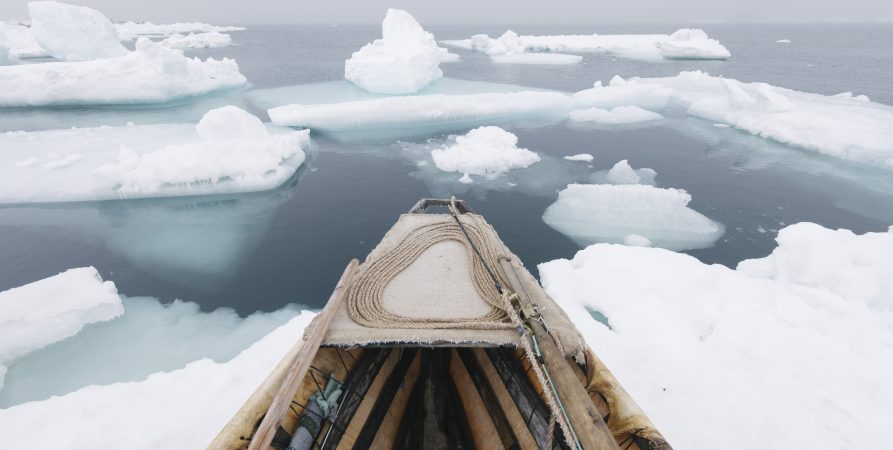Carving of a female holding a child or creature
Life Story
This beautiful sculpture of an armless female with a clinching creature or infant is exemplary of the early Old Bering Sea culture which appeared suddenly around AD 500 in the Bering Strait region. [1] The features of the female are carved in walrus ivory with the use of iron engraving tools. The iron would have been traded with inland Siberian peoples and travelled to the Bering Strait region.
The extensive use of walrus ivory in Old Bering Sea art is telling of the Old Bering Sea’s orientation on maritime hunting and it is unsurprising that the settlements were established in the vicinity of walrus haul-outs in the Bering Strait, along the western Chukchi Sea coastline, and on Sivuqaq (St Lawrence Island). Haul-outs are places where sea mammals come to land to rest or mate. With the abundance of sea-mammals, the Old Bering Sea peoples began to live year-round in larger villages. [2]
The exact purpose of this enigmatic sculpture is unclear but it could have been ceremonial to underscore the connection between spirits, humans, and animals or as an illustration of the intricate bond between mother and child. Whatever significance the sculpture held, the skilled carver took great care to carve out an eloquent and expressive facial features with a long thing nose, small mouth, eyebrows, and eyes with a set of two lines demarcating perhaps the hairline. Vertical lines with small dotes in between run down the front body of the female until the knees with horizontal lines around the waist and tights as if the female is wearing shorts. On the back of the body is an intricate design around the shoulders. The creature or infant, chipped but the body showing horizontal lines, clinches to the womb with two lines connecting it to the vulva. The lines might indicate tattoos similar to those that the Old Bering Sea’s successors, the Inuit, made on their bodies. [3]
Whilst the provenance of this sculpture is unknown, similar figures have been found on the Punuk Islands near St Lawrence Island, Alaska, and we could assume that this sculpture was made there. The lack of provenance details is not uncommon for Old Bering Sea objects and reflects the complex history of excavations in the Bering Strait region. There has been a long history of digging for “fossil ivory” by Indigenous Peoples for personal use and trade. [4] More recent colonial histories, however, would bring Europeans, Russians, and American to the Bering Strait for its natural and mineral resources. Some of them would illegally dig graves or trade with Indigenous Peoples for the valuable ivory and art. By the turn of the 20th Century, field collectors hired Indigenous Peoples to share information about the ancestral settlements and grave sites or hire them for excavation expeditions. Digging had become a form of subsistence to counter economic hardships that were consequential of the decimated effects that colonialism had on Indigenous livelihoods. [5]
Sivuqaq, and the adjacent Punuk Islands, had escaped the immediate effects of gold mining but nonetheless colonial agents in the form of teachers, doctors, museum collectors had become aware of the existence of the exquisite and highly valuable Old Bering Sea art. One of these agents was Norman Potosky, who would live on St Lawrence Island for several years to carry out archaeological research in the aftermath of World War II. He would sell his collection to the Denver Museum of Art which in turn sold part of their Arctic collection to antique dealers who subsequently sold them to fervent collectors such as Robert and Lisa Sainsbury. [6] This sculpture might well have been one of them.
Peter Loovers, February 2022
[1] Owen K. Mason, ‘Focusing on the Coast’, in Arctic: Culture and Climate, ed. by Amber Lincoln, Jago Cooper and Jan Peter Laurens Loovers (London: Thames&Hudson, in collaboration with The British Museum Press, 2020), pp 187-198
[2] Owen K. Mason and Jeff Rasic, ‘Walrusing, Whaling and the Origins of the Old Bering Sea culture’, in World Archaeology 51:3 (2019), 454-483
[3] For tattoo marks on figurines, see Lars Krutak, Sacrificing the Sacred: Tattooed Prehistoric Ivory Figures of St. Lawrence Island, Alaska, in Ancient Ink: The Archaeology of Tattooing, ed. by Lars Krutak and Aaron Deter-Wolf, (Seattle: University of Washington Press, 2017), Pp 262-285; Lars Krutak, Therapeutic Tattooing in the Arctic: Ethnographic, Archaeological, and Ontological Frameworks of Analysis, International Journal of Paleopathology, 25(2019), pp. 99-109
[4] Susan W. Fair, Alaska Native Arts and Crafts, (Anchorage : Alaska Geographic Society, 1985), p. 52-56
[5] Julie Hollowell, ‘Ancient Ivories in a Global World’ in Gifts from the Ancestors: Ancient Ivories of Bering Strait, ed. by William W. Fitzhugh, Julie Hollowell and Aron L. Cromwell, Strait (Princeton: Princeton University Art Museum, 2009), pp. 252-289, (p.276).
[6] Julie Hollowell, ‘Digging for Ivory on Bering Strait: A Long History of Licit Excavation’, in Challenging the Dichotomy: The Licit and Illicit in Archaeological and Heritage Discourses, ed. by Les Field, Cristóbal Gnecco and Joe Watkins (Tuscon: University of Arizona Press, 2016), pp 129-153
Provenance
Purchased by the Sainsbury Centre, University of East Anglia from Miriam Shiell in 1996 on the advice of Robert Sainsbury out of funds provided by the Robert and Lisa Sainsbury Charitable Trust.
On display
Title/Description: Carving of a female holding a child or creature
Object Type: Figure
Materials: Walrus ivory
Technique: Carving
Measurements: h. 211 x w. 51 x d. 36 mm
Accession Number: 1121
Historic Period: early Old Bering Sea (AD 500-750)
Production Place: Alaska, North America, St. Lawrence Island (?), The Americas
Cultural Group: Old Bering Sea (Okvik)
Credit Line: Purchased with support from the Robert and Lisa Sainsbury Charitable Trust, 1996
In from the Cold: Five Sainsbury Centre Treasures at the British Museum
Objects from the Centre’s collection offer snapshots of life in the Arctic
Continue reading
_01.jpg)




.JPG)
